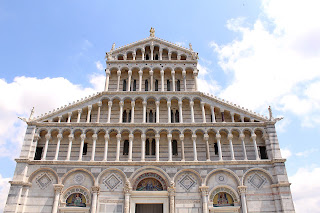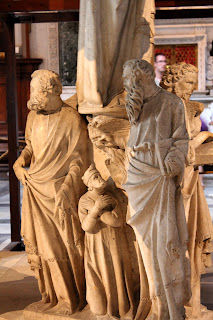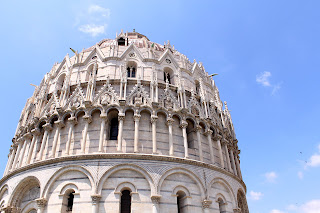My slice of Pisa
The Leaning Tower of Pisa is inarguably one of the most recognizable landmarks on the planet. Sure, I’ve seen small paper weights that looked like it even before I had my first taste of Italy. There was even a big picture of it on our Physics book way back in high school, which warranted a lengthy lecture on equilibrium featuring the poor tower that managed to stand in that angle over the centuries. And did Galileo Galilei really perform his experiment on top of the tower of Pisa, resulting in a universally accepted fact that objects regardless of their mass will fall at the same time? Big deal. The Leaning Tower of Pisa (Torre Pendente di Pisa in Italian) is pretty as it is storied.
And so during my latest sojourn to Europe, I chanced on a guided tour that took us to Lucca and Pisa. I wasn’t really interested on seeing the Leaning Tower of Pisa. What's in there aside from the tower, I thought. But it was just less than two hour's bus ride from Florence, Italy, so I succumbed to the band wagon.
More than the scientific side of things, I’ve learned a number of interesting things about the famous Leaning Tower of Pisa:
1. Upon getting there, it’s obvious: The Leaning Tower of Pisa is not a standalone structure that imposes itself within Pisa. It is part of a grand masterplan that includes a church (duomo), a baptistery, a hospital (ospidale) and a cemetery (camposanto or cimiterio). The concept of the place is, according to our tour guide, is this: a human is borne to this world (in the hospital), then baptized in the baptistery (outside the church because they believed someone who isn’t baptized yet cannot enter the church), centers his life in the church, and then dies and is buried at the cemetery.
2. The tower is actually intended to be a freestanding campanile of the church!
3. The Leaning Tower of Pisa stands in a place called Piazza del Duomo, or more popularly known as Piazza dei Miracoli (not to be confused with Campo dei Miracoli, which is a fictional place mentioned in Pinocchio, according to Wikipedia). The piazza used to be a lagoon 1,000 years ago!
Piazza dei Miracolli, where the Leaning Tower of Pisa is.
5. Construction of the tower commenced in 1173, making it the third oldest structure within the piazza. Aside from being constructed on a weak ground, the design was flawed right from the very start, that's why it started leaning during the construction of the second floor. Before the efforts to clean up the blackened walls and straighten the tower, the structure dips by about 1 millimeter a year!
6. If the tower is not leaning, it’s gonna be curved, anyway. The engineers who built the upper floors tried to compensate for the tilt by building walls with one side longer than the other.
7. The arches of the tower are made in Gothic and Romanesque fashion. Like the Colosseo in Rome, the schools of design differed from one floor to another as the construction of the upper floors came centuries after.
8. The tower is tilted by 3.9 degrees after it was straightened from more than 5 degrees of tilt. After some efforts – diggings, counterweights, cables, the works – engineers declared that the tower will be in its position as it is right now for at least 200 years, according to Wikipedia.
9. The tower took two centuries to be completed. Sometime in the 1300s, when it was still unfinished, Pisanos turned it into a clock tower. Currently, the campanile is not used as it is intended to be as vibrations of bells might affect the stability of the structure.
10. Efforts to straighten the tower were deliberately half-baked as keeping it to its tilted position is crucial in maintaining the tourism industry in Pisa. Yeah, I think they’ve succeeded in that aspect.
While there, it is advised to check out the duomo, known as the Santa Maria Assunta (Mary of the Assumption).
Facade of the duomo of Santa Maria Assunta.
A lot can be said about this magnificent cathedral, but these should suffice:
· The cathedral is heavily influenced by Muslim art as evident in the striped arches in the interior, which are made up of two colors of marble. This is very reminiscent of the Mezquita in Córdoba, Spain!
The striped arches inside the duomo of Sana Maria Assunta, Pisa.
Inside the Mezquita of Córdoba, Spain. Photo taken on June 2010.
· There is an upper level, which was originally meant for women church-goers. Men worship downstairs (yes, I think that’s the way they were back in the Medieval age).
· The ceiling is not the original as a fire sometime in the 1500s destroyed most of the church, including the artworks!
The ceiling of the duomo.
Inside the duomo.
· Currently there are 19 Baroque paintings in the church by important painters of Central Italy.
The painting at the dome!
o It features an eagle, which represents St. John the Evangelist (the saint is an important icon in Italian art).
o Designed by Giovanni Pisano and fashioned out of marble, it took 350 people and 10 years to finish the construction of this structure!
o The lions on the side represent the strength of Catholicism.
o The three women in this structure represent faith, hope and charity. The man kneeling is Gionvanni Pisano himself.
That's Pisano right there in the middle!
I couldn't comment anything intelligent about the baptistery, except that it is marvelous and that it looks like a huge cupcake.
Now the question: SHOULD YOU GO THERE? I normally would want to visit the same places that I’ve been to again and again, except for this one. Yes, Pisa is beautiful, and I do not regret coming over (as you can see from my pictures, it is obvious that I enjoyed photographing!). But I would like to quote what Lonely Planet Western Europe had to say about Pisa: “ Tower aside, Pisa is an unassuming university town that while pleasant enough, won’t claim your attention long.”
The Baptistery up close. Look at those details!
Now the question: SHOULD YOU GO THERE? I normally would want to visit the same places that I’ve been to again and again, except for this one. Yes, Pisa is beautiful, and I do not regret coming over (as you can see from my pictures, it is obvious that I enjoyed photographing!). But I would like to quote what Lonely Planet Western Europe had to say about Pisa: “ Tower aside, Pisa is an unassuming university town that while pleasant enough, won’t claim your attention long.”
Money Talk
· Aside from the 58 euro tour, entrance to the baptistery, cathedral and the cemetery costs 10 euros.
· Entrance to the tower is about 17 euros, and there are no lifts that would take you to the top. Be ready to climb more than 200 steps! Only 30 persons are allowed to climb at a given time. It is advised to book ahead.
· If you opt for the guided tour, the tour groups are right outside the Santa Maria Novella station (Florence main train station). Book a tour a day ahead. The whole guided tour to Lucca and Pisa costs 58 euros per person, excluding the lunch and the entrance to the tower itself. But I think you can do this trip on your own, even without the guides.
· If you opt for the guided tour, the tour groups are right outside the Santa Maria Novella station (Florence main train station). Book a tour a day ahead. The whole guided tour to Lucca and Pisa costs 58 euros per person, excluding the lunch and the entrance to the tower itself. But I think you can do this trip on your own, even without the guides.
· Trains leave from Florence almost every hour, and the one-and-a-half hour trip costs about $9, depending on the season.
















Comments